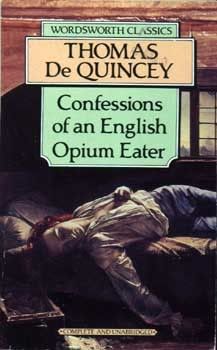
While there can be few works quite as remarkably of their time as these Confessions, but at the same time it’s a good reminder of the fact that even though zeitgeists, fashions and modes of expression can change hugely, people don’t change much at all. And I’m sure the quirky little work will serve to illustrate that point for many years to come.
I was surprised how little of the composition is actually concerned with opium, but then, the title promises only confessions, not necessarily on the subject that defines he who confesses. The bulk of the slim volume is an autobiography, with some short chapters at the end discussing the pains and pleasures of laudanum consumption, linked by a short admission that the two parts are linked only tenuously, the opium use of later years inextricably linked to the experiences of youth, they being both a cause for its use and having an effect on the vivid dreams that were its result.
But while some inkling of the mindset of an addict and a vivid impression of some aspects of life in England two centuries ago are inviting aspects of de Quincey’s work, what really fascinates is de Quincey himself, the way his stream-of-consciousness comes tumbling out in a way that makes Virginia Woolf’s prose look most affected, and the way he himself seems totally unaware of his idiosyncrasies. He admits he has less structured his narrative than ‘thought aloud’, and this is exactly right; he chases after tangents like a kitten after an unravelling ball of wool. We hear in great grandiloquent detail Quincey’s thoughts on the piano, and which Roman historian was his favourite, and bizarre episodes like the time a large swell of water in a canal required him and another pedestrian to run away, which he considered one of the only times it is permissible for a 19th-century gentleman to begin a conversation with a lady with whom he is not yet formally acquainted. But then when something really interesting comes along, like his time living in a squalid little flat with some horribly neglected little child, or when he befriends a young prostitute, the details get skipped over and we don’t hear nearly as much as we might like.
But then, that uneven sense of what is and is not important only adds to de Quincey’s perceived character – while his language is beautifully wrought and glazed in the conventions of his era, where broadness of vocabulary and sophistication of grammatical construction were prized, he dances about from subject to subject with a childlike charm that makes him very likeable. And his uneven relationship with his drug, his fear, his adoration, his feelings of being master and uncomprehending subject, make this aspect of him fascinating.
The dense language makes the slim little book quite hard to get through in casual sittings, being much better suited to an extended burst of concentration, and since the Wordsworth Classics edition I read (with the dubious choice of ‘The Death of Chatterton’ for its cover – I know that painting is often pointed to as more erotic than morbid, but he’s still dead and pretty, neither of which de Quincey was at the time!) had no annotations, I felt like a lot I might have learned would take more effort than it was worth to look up, which was a bit of a shame – though not enough for me to actually write them down and look them up. The experience of such a fine character as de Quincey, who proves fiction is often stranger than reality, is enough.
No comments:
Post a Comment